
* In the postwar period, the Beech Aircraft Company focused primarily on civil aircraft, but leveraged their technology into a two-seat piston trainer, the "T-34 Mentor". Hundreds were built, with the US Air Force obtaining it as the "T-34A" and the US Navy as the "T-34B"; it was also supplied to many US allies. In the 1970s, the Navy decided to obtain a turboprop-powered version, the "T-34C Turbo Mentor", which served into the 21st century. This document provides a history and description of the Beech Mentor series, include the series of variants developed by Fuji Heavy Industries of Japan.
* After World War 2, the Beech Aircraft Company scored a hit with its Bonanza single-engine piston four-seater. Walter Beech decided it might be a good idea to leverage the recently-introduced Bonanza into a military trainer, intended to replace the North American AT-6 Texan. Beech was looking down the road a ways, since the military didn't have funds at the time for a new trainer, and had plenty of Texans left over from the war. They were not economical to operate, nor getting more so as they got older, and would have to be replaced sooner or later.
Beech took a bet and funded the trainer on company funds. The first of three "Beech Model 45" prototypes performed its initial flight on 2 December 1948, with test pilot Vern Carstens at the controls. The Model 45 inherited major features from the Bonanza:
The Model 45 differed from the Bonanza in having a slender fuselage with tandem seating and dual controls, under a bubble canopy, with both crew under individual back-sliding canopy elements. The canopy had an emergency release mechanism to permit escape if it came to that. The Model 45 was also much stronger than the Bonanza, being designed for +10g and -4.5g flight stress.
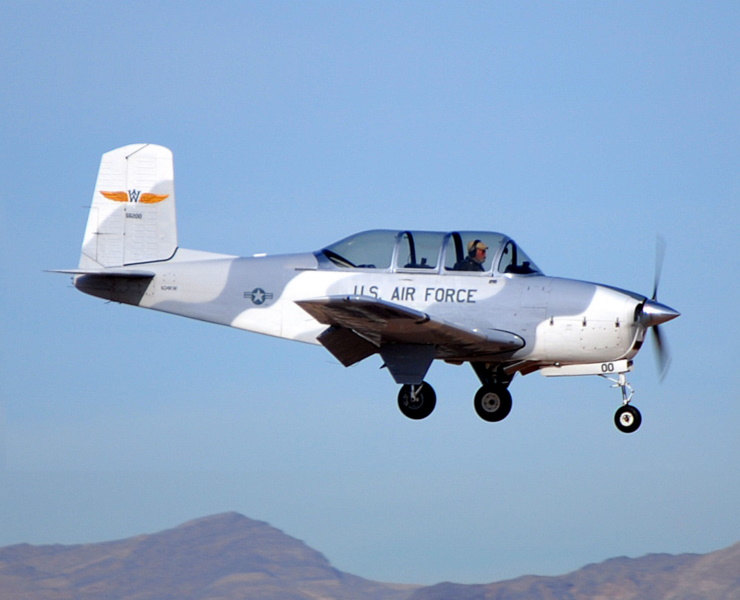
The US Air Force eventually got around to order three "A45T" AKA "YT-34" machines for evaluation. Compared to the original prototypes, they had a simplified canopy roll-protection scheme, and an O-470-13 engine -- an improved version of the E225-8 engine, also with 165 kW (225 HP), but with bigger ejector exhausts to the engine. The military was in no hurry to obtain the type, with Beech not providing "T-34A Mentor" trainers to the US Air Force until 1953.
___________________________________________________________________
BEECH T-34A MENTOR:
___________________________________________________________________
wingspan:
10 meters (32 feet 20 inches)
wing area:
16.7 sq_meters (180 sq_feet)
length:
7.9 meters (25 feet 11 inches)
height:
2.92 meters (9 feet 7 inches)
empty weight:
978 kilograms (2,156 pounds)
operating weight:
1,338 kilograms (2,950 pounds)
max speed:
305 KPH (190 MPH / 165 KT)
service ceiling:
5,550 meters (18,200 feet)
range:
870 kilometers
___________________________________________________________________
From 1953 to 1956, Beech made 353 T-34As for the USAF, while Canadian Car & Foundry (CCF) built 125 -- 100 of those for the USAF, 25 for the Royal Canadian Air Force (RCAF). Of the 25 RCAF machines, one was lost in a crash, while the others were passed within a few years on to Turkey; the Mentor never took root in Canada. The last T-34As were rolled out in 1956.
The USAF retired their T-34As in the early 1960s, being replaced in the "ab initio" flight training by the T-41 Mescalaro, a variant of the popular Cessna 172. Some of the retired T-34As went to US allies, others to the US Civil Air Patrol, with a number ending up in civilian hands. The civil T-34s were grounded by the US Federal Aviation Administration (FAA) in 2004 due to crashes following structural failures, but were restored to flight status after the FAA issued a service document in 2011. T-34s are still flying on the airshow circuit.
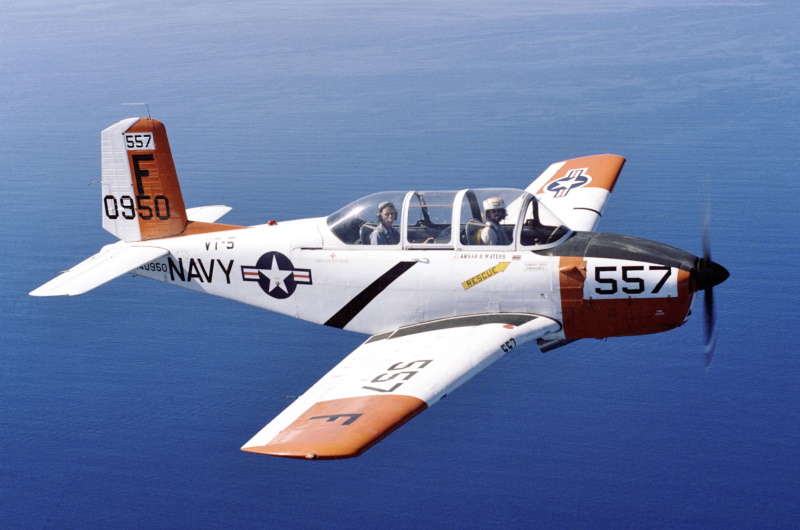
* In 1955, Beech began production of the "T-34B" for the US Navy. It looked much like the T-34A externally, but had a number of tweaks:
Along with Navy practices, one of the alternate reasons for the tweak was that the Navy would have had to soak up T-34 development costs if the service also obtained the T-34A. Beech built a total of 423 T-34Bs from 1954 to 1957.
BACK_TO_TOP* Beech also built an export version of the T-34A, the "Model B45". It looked just like a T-34A, the difference being use of vacuum instruments instead of electrical instruments. In some cases they were armed, with a 7.62-millimeter machine gun in each wing and underwing pylons for light munitions. Beech built 161 of them, and provided kits to FMA of Argentina to build 75 more. 162 were also produced by Fuji Heavy Industries in Japan. They generally retained the T-34A designation in foreign service.
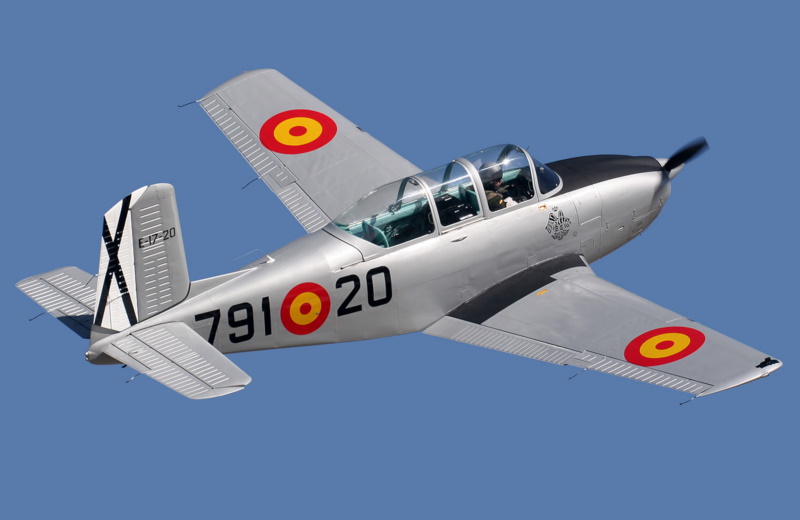
Since many foreign users also obtained hand-me-down T-34s from the US or other countries, it's not easy to trace the exact origins of all the Mentors in foreign service. In any case, foreign T-34 users included:
The Mentors were generally phased out of military service from the late 1970s, with a number ending up in civilian hands. Some flying at airshows that are painted in US Navy colors are referred to as T-34Bs, though they have the T-34A-style rudder; it is not clear if that is a misidentification, or the rudders were updated. In the 1980s, Allison offered upgraded Mentors with an Allison 250 turboprop engine as the "AT-34", but there were no takers. However, upgrades are available for T-34s, including more powerful engines, such as the IO-520-R, with 230 kW (310 HP); wingtip tanks; a partial glass cockpit; and LED lighting.
BACK_TO_TOP* In response to a request from the JGSDF for a liaison aircraft, Fuji engineers developed a derivative of the Mentor with a four-seat fuselage, designated the "Liaison Mentor (LM) 1". The modified fuselage had two bucket seats in the front, and a bench seat in the back; a fifth seat could be crammed in behind the front seats if needed. Another difference was that the LM-1 had a control yoke, not sticks. 27 were built in 1956 and 1957.
Three were updated in the 1960s to the more powerful fuel-injected Lycoming IGSO-480-B1A6 engine with 255 kW (340 HP) -- these machines being designated "LM-2". All the LMs were out of service by the early 1980s. A single copy of the LM-1 was built by the Royal Thai Air Force as the "RTAF-1" in 1957, though the Thais didn't build any others.
Another LM-1 was updated with the same engine and in a civil configuration, with the "XKM" performing its first flight in 1958. Only one production KM-1 was built, flying with the Japanese Department of Transportation. However, the KM-1 wasn't a waste of effort. The JMSDF wanted a side-by-side trainer -- JMSDF flew patrol aircraft and such, all with side-by-side seating, while the JASDF flew single- or tandem-seat fighters -- and so Fuji modified the KM-1 appropriately as the "KM-2", with full dual controls, the entry door moved to the left side of the fuselage, and rooftop windows.
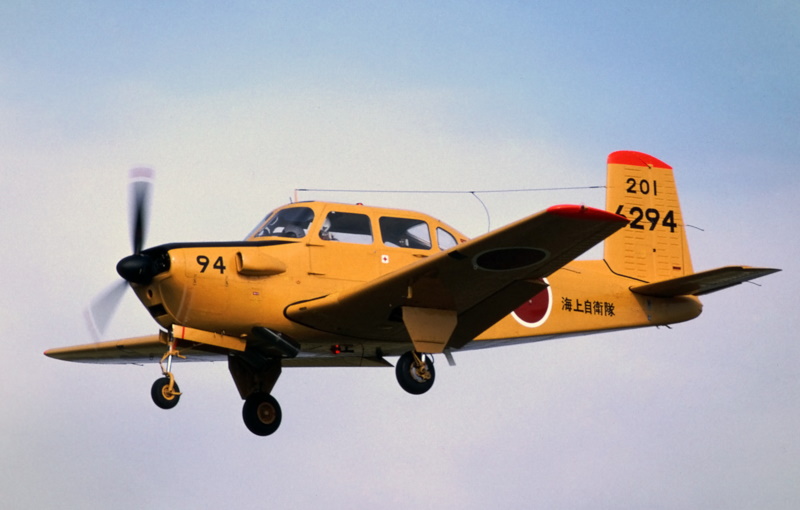
62 KM-2s were provided to the JMSDF from 1962, in two batches. There were 28 in the first batch, all of them retired by 1969, to be replaced by the 34 in the second, modestly refined batch. The JGSDF also obtained two KM-2s under the designation of "TL-1".
The JASDF later got interested in the KM-2, but wanted a tandem-seat configuration, with Fuji coming up with the "KM-2B", first flight being in 1974. Along with the T-34-style tandem cockpit, it had modernized avionics. 50 were obtained by the JASDF as the "T-3".
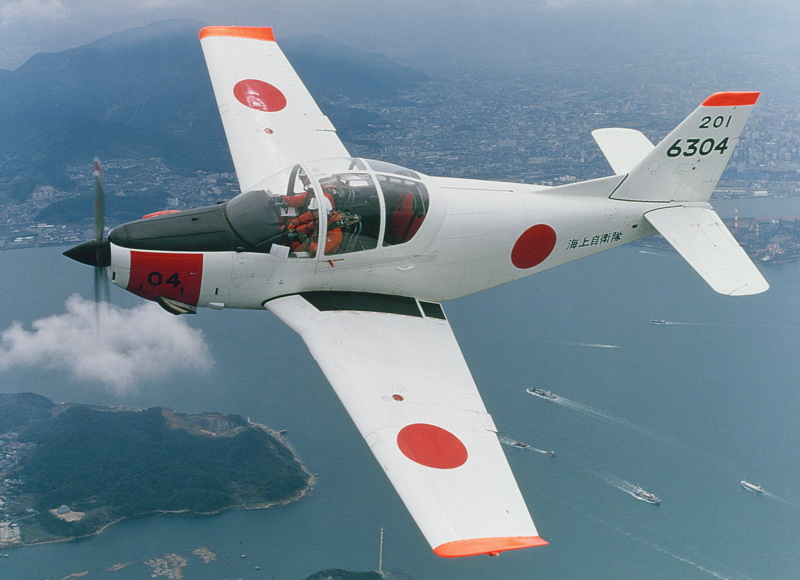
The JMSDF liked their KM-2 trainers very much. When they were getting elderly, Fuji promoted a replacement with a Rolls-Royce Allison 250-B71D turboprop engine with 260 kW (350HP), flying a KM-2 refitted with the new engine in 1984 as the "KM-2D". The JMSDF was interested, with the demonstrator leading to the "KM-2 Kai" design -- where "Kai" was short for "kaizen", meaning "improvement" -- featuring the turboprop engine with a three-bladed prop, along with a bubble-type canopy for the side-by-side cockpit, the canopy sliding backwards to open; a swept tailfin with a prominent forward fillet; and upturned wingtips. The JMSDF obtained 40 under the designation of "T-5", first deliveries being in 1988.
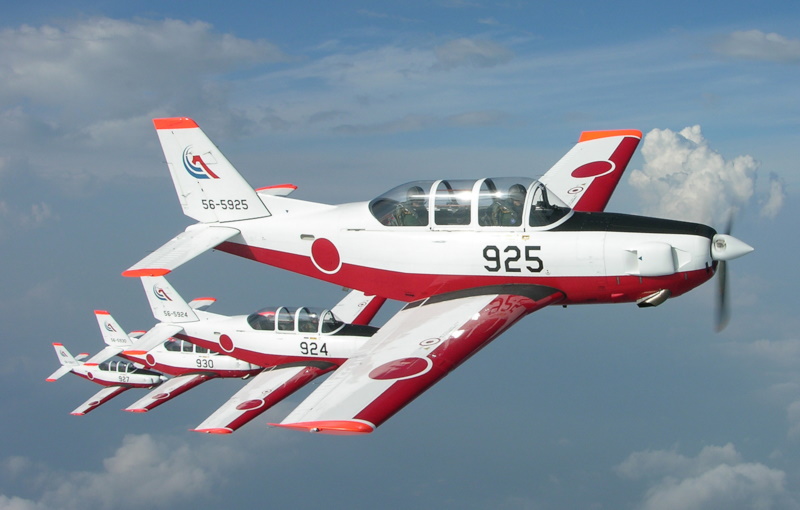
As for the JASDF T-3s, they served beyond the end of the century, being replaced from 2002 by the Fuji "T-7", original "T-3 Kai" -- which was much like the T-5, except for a tandem cockpit. It had a Rolls-Royce / Allison 250-B-17F turboprop engine with 335 kW (450 HP), driving a three-blade propeller, along with the swept tailfin and upturned wingtips. 49 were produced. At last notice, both the T-5 and T-7 were still in service. Apparently, some of the Fuji piston-powered Mentors ended up in civilian hands.
BACK_TO_TOP* In 1955, Beech flew a jet-engine derivative of the Mentor, again with private funding, with initial flight of the "Model 73 Jet Mentor" on 18 December 1955. It differed noticeably from the Mentor in featuring a redesigned cockpit, moved forward, as allowed by eliminating the piston engine; and air intakes in the wing roots for a Continental J69 centrifugal-flow turbojet, with 4.1 kN (4.15 kgp / 920 lbf) thrust. The J69 was a variant of the French Turbomeca Marbore II turbojet, built under license.
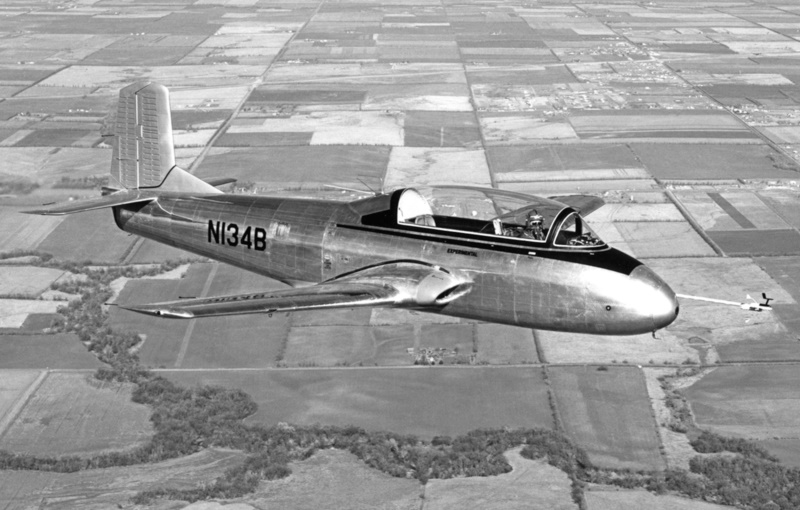
The Jet Mentor also had ejection seats. The Air Force evaluated the Jet Mentor, but decided to obtain the Cessna T-37 instead. The Navy similarly chose the Temco TT Pinto instead, but gave up on it, and used the T-34B along with the North American T-28 Trojan for primary flight training. The single Jet Mentor survives as a museum display.
* The T-34 had a second life, thanks to a Navy request for a turboprop variant of the Mentor. Beech re-engined two T-34Bs supplied by the Navy with a Pratt & Whitney Canada PT-6 turboprop engine, the first of these two "YT-34C" machines making its initial flight on 21 September 1973. Trials going well, the "T-34C" Turbo Mentor entered production for the Navy in 1975.
The production T-34C was powered by a PT6A-25 turboprop with 410 kW (510 SHP), driving a 3-bladed Hartzell variable-pitch prop. Fuel supply was 490 liters (130 US gallons), much more than the T-34A. Other than that, the configuration of the T-34C was much like that of the T-34A, with much the same cockpit, landing gear, and flight surface arrangement. Changes did include an airframe reinforced to handle higher take-off weight; it also had a bigger tailfin, twin fixed ventral fins, plus long strakes on the fuselage forward of the tailplane surfaces, to improve spin handling.
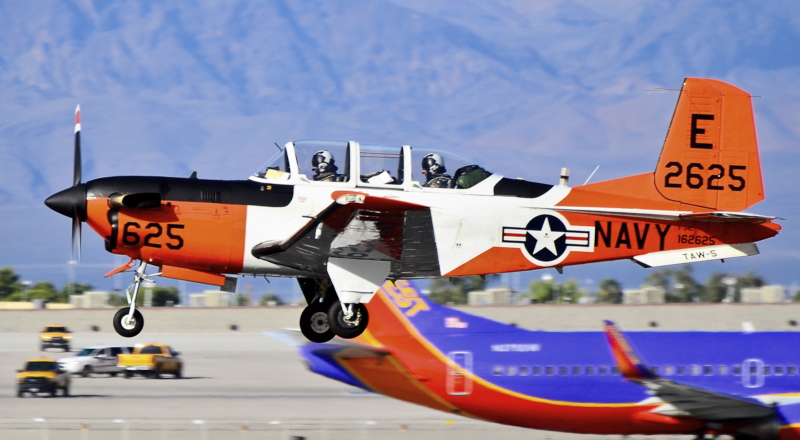
The Navy obtained 353 T-6Cs from 1977 to 1990. The US Army obtained six hand-me-down T-34Cs from the Navy, using them as trials platforms and chase planes. Two were also obtained from the Navy by the US National Aeronautics & Space Administration (NASA) for trials.
A "T-34C-1" was also produced for the export market, this variant having armament capability, with four underwing hardpoints. The inner hardpoints had a capacity of 270 kilograms (600 pounds) each, while the outer hardpoints had a capacity of 135 kilograms (300 pounds) each, with a total load capacity of 545 kilograms (1,200 pounds).
___________________________________________________________________
BEECH T-34C TURBO MENTOR:
___________________________________________________________________
wingspan:
10.16 meters (33 feet 4 inches)
wing area:
16.7 sq_meters (180 sq_feet)
length:
8.75 meters (28 feet 8 inches)
height:
2.92 meters (9 feet 7 inches)
empty weight:
1,343 kilograms (2,960 pounds)
max take-off weight:
1,950 kilograms (4,300 pounds)
max take-off weight, weapons trainer:
2,500 kilograms (5,500 pounds)
cruise speed:
395 KPH (245 MPH / 215 KT)
service ceiling:
9,100 meters (30,000 feet)
range:
1,310 kilometers (815 miles / 710 NMI)
___________________________________________________________________
129 T-34C-1s were built in all, export users including:
Six Argentine T-34C-1s were flown in a scouting role during the 1982 Falklands War, in one case jumping a Royal Navy Sea King helicopter, but being driven off by RN Sea Harriers. Three were later destroyed, along with one damaged, by SAS commandos during a raid. This was apparently the only active combat service of any of the Mentors. The damaged aircraft was taken back to Britain as a display trophy.
A civil "Turbine Mentor 34C" was introduced -- not, it seems, in search of private buyers, but for governmental sales where a military type was undesireable. Six were sold to the Algerian national pilot training school in 1979.
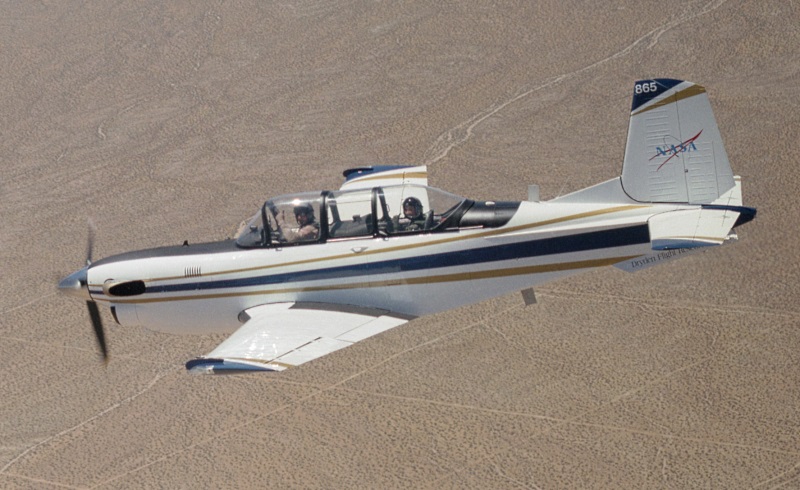
The T-34C remained the US Navy's primary trainer for over three decades, finally being replaced by the Raytheon T-6 Texan II. Turbo Mentors may linger in service here and there, but not for much longer.
BACK_TO_TOP* Revision history:
v1.0.0 / 01 jan 22 v1.1.0 / 01 feb 23 / Format update. v1.1.1 / 01 dec 23 / Review & polish.BACK_TO_TOP
